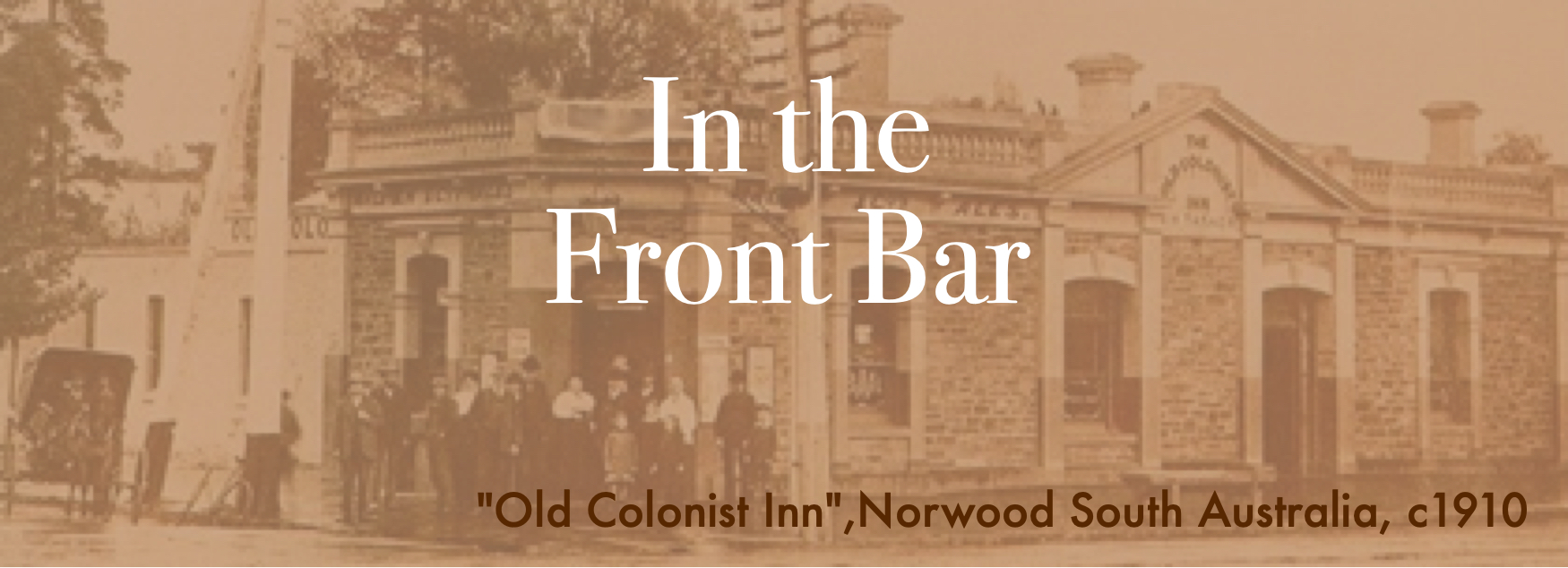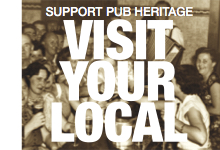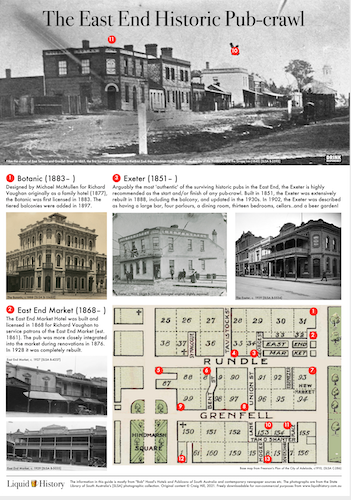


DRAFT/REVIEW ONLY - NOT FOR DISTRIBUTION
The East End Historic Pub-crawl
|
The anticipated relaxation of COVID-16-related restrictions and the imminent opening of Adelaide's festival season, especially in the north-eastern corner of the City of Adelaide, has prompted a guide to a self-guided walking tour of the historic pubs of the East End: the East End Historic Pub-crawl.
The 'East End' has been home to thirteen licensed public houses. The first, the Woodman, was built and licensed in 1839 and the most recent, in 1910, was the Grand Central Hotel, previously the York. Of the thirteen pubs, five have survived as more-or-less traditional pubs (a good basis for a pub-crawl) plus one now more as a cocktail bar. The futures of two are uncertain and five have succumbed to urban development. Now more than ever it is important that we appreciate the historical importance of the remaining pubs...and support them by enjoying a convivial and COVID-safe drink or two with friends in their front bars. Like all other Liquid History self-guided historic pub-crawls, the East End Historic Pub-crawl can be freely downloaded for non-commercial purposes by clicking on the image to the right. |
 |

The East End Historic Pub-crawl self-guided walk |
...a short note on the wine saloon(s) of the East End...
From early 1866 pubs were not the only places in which in which the public could share a convivial and legal drink or two with friends in the the East End.
|
The Licensed Victuallers Act Amendment Act of 1865-66 permitted a fit and proper person holding a wine licence (a category introduced in 1863) "to sell in the house or shop...mead, [South Australian] wine, cider and perry...in any quantity and the same may be consumed on the premises or otherwise", so making possible wine saloons or bars or "shades" as well as licensed restaurants, chop houses, oyster bars and similar establishments that served alcoholic beverages. The cost of an annual wine license was about a tenth of that of a publican's license, did not require the licensee to provide accommodation and was generally far less restrictive. Unsurprisingly, as the graph to the right shows, the number of wine licenses increased twelve-fold in the five years from 1863 to 1867; the average number of wine licenses in the fifty years from 1863 to 1914 was 130 compared to 645 for pubs, about a fifth the number.
J. Allert & Co's Ambrosia Wine Hall opened in June 1877 at 220 Rundle Street (the number was later changed to 242), three doors west of the Exeter Hotel. The premises had been built the previous year for Hienrich Ludwig Vosz, an entrepreneurial German carpenter, ironmonger, paint manufacturer, decorator and philanthropist. With various names, owners and licensees, the site remained a wine saloon/bar until March 1985 when the Campari Wine Bar became the Campari Restaurant and the license changed accordingly. The Ambrosia Wine Hall had close associations with South Australia's German community. As shown in the table below, at least eight of its first nine licensees were German-speaking or of German extraction, advertised regularly in the local German press and offered such northern European drinks as 'hot spiced wine'. |
 |

Number of wine licenses granted, 1863-1914 [South Australian Statistical Register, 1864 - 1914; click to enlarge] 
Description of Vosz' shops, 1876 [South Australian Advertiser, 10 January 1877, p.6] |
Licensees of the Ambrosia/Rowland wine saloon, 1877-1923
| Name | Licensee from | Place of origin | ||
| Jacob Allert | June, 1877 | Danzig, East Prussia | ||
| Johann C C Maass (Captain) | March, 1888 | Hamburg? | ||
| Carl Stephan | April 1898 | [not known] | ||
| Karl "Carl" [August?] Menzel | May 1901 | [probably Posen, Prussia] | ||
| Ulrich Eberli | November, 1903 | Switzerland | ||
| Emma Eberli (wife of Ulrich) | November, 1914 | Switzerland | ||
| Johann "John" Tietz | November, 1918 | [Western] Poland | ||
| Lyndon B Smith | August 1923 | [not known]] | ||
|
Richard Gramp Frederick Altmann Frank Page (or others) |
November 1923... [until at least 1935] |
[not known] |
|
|

Jacob Allert's Ambrosia Wine Hall, 1890 [State Library of Victoria] 
German-language advertisement for Allert's Arcadia Wine Hall, 1877 [Australische Zeitung, 26 June 1877, p.5]
|
|

Rowland Wine Cafe, 1924 [SLSA B-2240] |
...and a shorter note on the York Hotel
The York Hotel on the corner of Rundle and Pulteney Streets and now long since demolished - and replaced by a car park - was the grand old lady of East End pubs. It was first licensed in 1849 and its successor, the Grand Central Hotel, closed effectively in 1924. Over these 75 years, through extensions and rebuilding, the face of the York changed probably more than any other pub in Adelaide, reflecting the changing roles of hotels.


|


|

|
Left, top The York Hotel, 1852; Left, bottom ...in about 1862; Centre, top ...in the 1870s;
Centre, bottom ...in 1894; Right The Grand Central, 1924 [SLSA B3708, B30206, B953, B135, B13016]
Posted 10 December 2021 Original content © Craig Hill 2021

